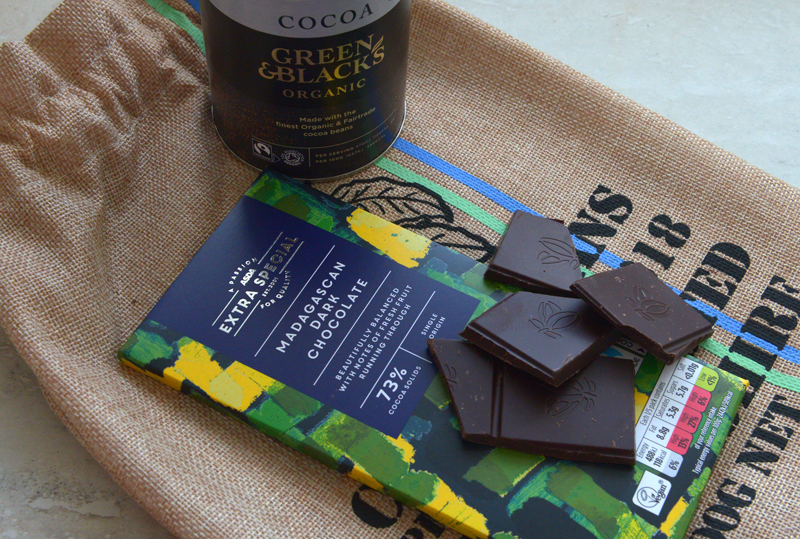You are viewing 1 of your 1 free articles. For unlimited access take a risk-free trial
Cocoa and health: turn to the dark side
Should chocolate be considered a desirable or even essential addition to an athlete’s diet? SPB looks at some brand new research on the link between dark chocolate consumption, cardiovascular health and gut health
In another recent article, we looked at some new research on the link between gut health and athletic performance. Essentially, this research suggests that improving gut health by supplementing with friendly bacteria can result in significant performance gains for athletes in training – the take home message being that optimizing gut health through good diet and probiotic supplementation is something that all athletes should consider when planning a nutrition strategy. Well, just as we put the finishing touches to that article, a new research paper dropped on cocoa products for athletes – specifically how they can impact gut health, and cardiovascular health. That being the case, we felt it was only right to also report on what this paper has discovered and what it means for athletes!
Cocoa and health
It was around the turn of the century when scientists began to take an earnest interest in the potential health benefits of cocoa products such as dark chocolate and cocoa beverages. At that time, there was a growing understanding of the role of naturally occurring plant antioxidants (phytochemicals – see this article) in human health, and it was soon identified that the humble cocoa bean was a very rich source of source of polyphenol and flavanol antioxidants, which are known to help reduce the incidence of various degenerative diseases, especially cardiovascular disease(1).
In particular, it soon became apparent the there was an inverse association between the intake of flavanol-rich cocoa products and blood pressure(2). In short, consuming higher levels of flavanols in cocoa products seemed to result in lower (and healthier) blood pressure levels. These findings were also supported by real world observations; the Kuna Indians in the Caribbean consume large quantities of flavanol-rich cocoa powder and have very low levels of blood pressure compared to Western societies. They are also known to have very high levels of longevity - presumably through improved cardiovascular health thanks to the high flavanol intakes(3).
Benefits for all
As research has progressed, the benefits of cocoa products have now been observed more widely across different populations. In a 2022 study on cocoa consumption and health/mortality, researchers found a highly protective effect from cocoa(4). Regardless of other health factors such as body mass index and blood cholesterol levels, scientists found that there was significantly lower risk of mortality from cardiovascular disease, heart disease and cancer of 13%, 16% and 12% respectively when cocoa consumption was high compared to when it was low or nil. A reduction in blood pressure accounted for only around 4.3% of this reduced risk, indicating that while there is a protective effect associated with reduced blood pressure and cocoa consumption, this protection extends into other aspects of health too!
Many of the cardiovascular benefits (and potential performance benefits) arising from cocoa product consumption are believed to occur via improved blood flow - particularly through the micro-capillaries of muscle tissue - thanks to the flavanols present(5-8). Cocoa flavanols achieve this by stimulating an enzyme call ‘NO synthase’, which leads to high levels of nitric oxide (NO) synthesis. NO is a powerful blood vessel relaxant, enabling blood vessels to dilate (vasodilation), resulting in improved blood flow and reduced blood pressure. Of note is that NO-mediated vasodilation is the same mechanism of action that produces sub-maximal exercise benefits in athletes who consume nitrate-rich beetroot juice.
In a previous SPB article, we looked at a thorough review of the data about this effect, which found that the increase in NO-mediated improved blood flow effects from cocoa product consumption resulted in health benefits across the board, including already fit athletes. However, in the latest research we’re about to discuss, the researchers looked specifically at athletes, to see if consuming cocoa products benefited not only cardiovascular health, but also gut health (which as mentioned, researchers now believe plays a significant role on muscle function and athletic performance).
New research
In this brand new study, which was published in the ‘International Journal of Sport Nutrition and Exercise Metabolism’ a team of Italian and British researchers investigated the impact of consuming dark chocolate in professional and highly trained soccer players(9). (NB: dark chocolate is typically defined as chocolate with no added milk and containing a high proportion of cocoa solids – usually 70% or more) As mentioned above, the researchers not only wanted to investigate the effect of dark chocolate consumption on markers of cardiovascular health, but they also wanted to see if it had an impact on gut health.
In addition, they looked at whether dark chocolate consumption was able to positively impact the omega-3 status of the soccer players by improving their omega-3 index (O3I). The omega-3 index (see this article) measures the proportion of essential omega-3 fats in the body compared to other lipids; in most people consuming Western diets, omega-3 status is insufficient, which is not only bad for cardiovascular health, but can also increase inflammation and oxidative stress following exercise – a bad thing for athletes!
What they did
In this 30-day intervention study, 38 professional male soccer players were recruited then randomly assigned to one of two experimental groups:
· Dark chocolate – in this group, the soccer players consumed 30 grams of dark chocolate per day for 30 days.
· Control group - in the control group, the players consumed 30 grams of white chocolate for 30 days. This chocolate was similar in composition to the dark chocolate except that being white, it contained no cocoa solids (and therefore no antioxidant flavanols).
During the intervention, the soccer players were instructed to maintain their normal dietary patterns (as supervised by a dietician), and avoid consuming other foods that are rich in flavanols. They were also instructed to maintain their normal training habits – ie to ensure the only significant variable was the dark vs. white chocolate consumption. At the start of the intervention and again at the end, measurements of the players anthropometric data (weight, body fat %, lean muscle mass etc) were taken along with samples of blood. These blood samples measured antioxidant levels, total cholesterol (both high and low-density cholesterol) and blood lipids. In addition, before/after faecal samples were taken to determine if and how the gut microbiota of the players had changed over time with dark chocolate consumption.
What they found
As might be expected, the blood levels of polyphenolic antioxidants rose significantly in the soccer players consuming the anti-oxidant-rich dark chocolate, whereas there was no change in the control (white chocolate group). There were no changes in body composition in either group (ie the dark or white chocolate consumption had no impact on weight or body fat). However, there were a number of key differences between the two groups. In particular, compared to the control group where no significant changes were observed, the dark chocolate group experienced the following:
· A decrease in total blood cholesterol, which fell by 32mgs/dl (very significant considering the upper limit for normal total cholesterol is around 190mg/dl).
· A drop in LDL cholesterol (the kind associated with increased risk of cardiovascular disease) of 18.5mg/dl and an increase in ‘cardio protective’ HDL cholesterol of 3.3mg/dl.
· A drop in blood triglycerides of 6.3mg/dl (high blood triglycerides are associated with increased cardiovascular risk).
· A very large and positive impact on a key determinant of omega-3 index – the arachidonic to eicosapentaenoic acid (AA:EPA) ratio. Where excessively high levels of AA are present compared to EPA, omega-3 status is poor. When levels of EPA are relatively high compared to AA levels, omega-3 status is good. The changes observed showed a 54% improvement in this ratio compared to the control group.
· A more stable gut flora balance throughout the 30-day intervention, with fewer fluctuations than were seen in the control group (indicating more robust gut health).
Take home advice for athletes
The researchers concluded that consuming 30 grams of dark chocolate per day over four weeks not only positively improved markers of cardiovascular health, but also improved polyunsaturated fatty acid metabolism, helping to favorably impact omega-3 status as well as gut health - in particular the stability of gut flora during periods of intense training. They recommended therefore that dark chocolate consumption can be considered as an effective nutritional strategy in elite sport environments during periods of high-intensity training and congested competitions.
In terms of practical advice, if you like the taste of dark (70% or more cocoa solids) chocolate, consuming it will not only be enjoyable for you but could well help your health and recovery as part of a good, wholesome, natural diet. Remember however, it is the cocoa that supplies the healthy flavanols; milk chocolate or dark chocolate with low cocoa content will deliver quite a lot of sugar without much of the antioxidant content you want! Remember too that the amount of dark chocolate found to be effective was just 30 grams per day, which is quite a modest amount. And given that cocoa is the active ingredient in dark chocolate, don’t forget other cocoa products can be used to deliver these benefits too. Below are a few practical tips to help you navigate your way around!
Practical advice on using chocolate
Want to increase your intake of cocoa products? Here are some tips and guidelines:
· Use dark chocolate – it contains a small amount of sugar and vanilla along with cocoa liquor, cocoa butter and cocoa powder (collectively termed ‘cocoa solids’). For example, 100g of 70% cocoa-solid chocolate contains 70g of cocoa solids and around 30% sugar. A 100g bar of 85% cocoa-solid chocolate contains 85g of cocoa solids and just 15g of sugar. These types of chocolate contain high levels of polyphenols and flavanols due to their high cocoa solid content and relatively low levels of sugar (a good thing).
· Avoid milk chocolate – yes, it also contains cocoa solids, but unlike dark chocolate, contains added milk and quite a bit more sugar than dark. For example, a 100g bar of a typical milk chocolate contains around 25-30g of cocoa solids and 55g of sugar. Although milk chocolate contains some flavanols therefore, the levels are much lower than in high-cocoa solid dark chocolate - explaining why those looking for health and performance benefits should always choose dark chocolate over milk.
· Cocoa content - If you’re already a dark chocolate fan, consume around 30g or so per day – that’s 3 squares of a typical 100g bar). As mentioned above, 70% or more cocoa solid chocolate is recommended and 85% is even better as there’s even more cocoa and less sugar. More than this however (ie 90% and above) and the chocolate starts to become quite bitter and far less palatable.
· Sweetness - If you’re a milk chocolate fan, you’ll be used to much higher levels of sweetness. To start with, try consuming some 50% cocoa solid dark chocolate and once your taste buds adapt, try moving up to 60% then 70%. And in case you’re worried, unlike sugar-filled milk chocolate, you’ll soon discover that a couple of squares or so of dark, high cocoa solid chocolate is very satisfying!
· Drinks – cocoa can also be consumed as a drink to top up your flavanol intake. But make it with pure (preferably organic) cocoa powder mixed with a little sugar and some milk to taste. Do not use premixed hot chocolate powders, which contain only small amounts of cocoa and lots of sugar!
References
1. Biosci Biotechnol Biochem. 2000 Dec;64(12):2581-7
2. J. Cardiovasc. Pharmacol. 2009;54:483–490
3. J. Am. Soc. Hypertens. 2009;3:105–112
4. Eur J Epidemiol. 2022 Apr;37(4):321-333
5. Nitric Oxide. 2019 Apr 1; 85():44-52
6. Med Sci Sports Exerc. 2014 Dec; 46(12):2326-34
7. J Strength Cond Res. 2016 Dec; 30(12):3520-3524
8. J Appl Physiol (1985). 2010 Jul; 109(1):135-48
9. Int J Sport Nutr Exerc Metab. 2024 Aug 7:1-13
Newsletter Sign Up
Testimonials
Dr. Alexandra Fandetti-Robin, Back & Body Chiropractic
Elspeth Cowell MSCh DpodM SRCh HCPC reg
William Hunter, Nuffield Health
Newsletter Sign Up
Coaches Testimonials
Dr. Alexandra Fandetti-Robin, Back & Body Chiropractic
Elspeth Cowell MSCh DpodM SRCh HCPC reg
William Hunter, Nuffield Health
Keep up with latest sports science research and apply it to maximize performance
Today you have the chance to join a group of athletes, and sports coaches/trainers who all have something special in common...
They use the latest research to improve performance for themselves and their clients - both athletes and sports teams - with help from global specialists in the fields of sports science, sports medicine and sports psychology.
They do this by reading Sports Performance Bulletin, an easy-to-digest but serious-minded journal dedicated to high performance sports. SPB offers a wealth of information and insight into the latest research, in an easily-accessible and understood format, along with a wealth of practical recommendations.
*includes 3 coaching manuals
Get Inspired
All the latest techniques and approaches
Sports Performance Bulletin helps dedicated endurance athletes improve their performance. Sense-checking the latest sports science research, and sourcing evidence and case studies to support findings, Sports Performance Bulletin turns proven insights into easily digestible practical advice. Supporting athletes, coaches and professionals who wish to ensure their guidance and programmes are kept right up to date and based on credible science.











